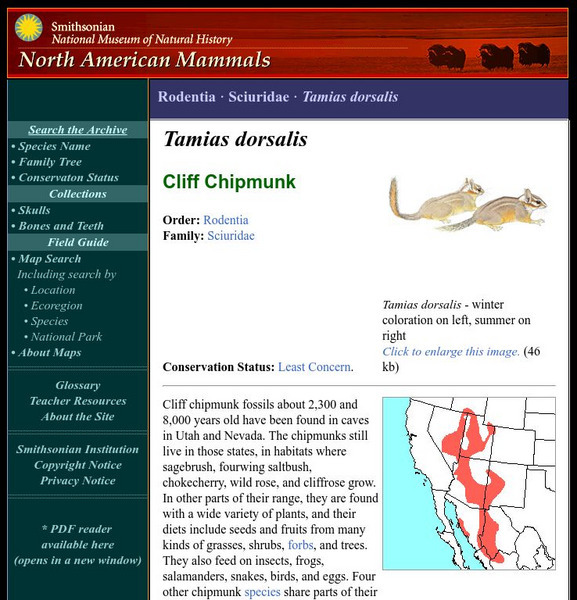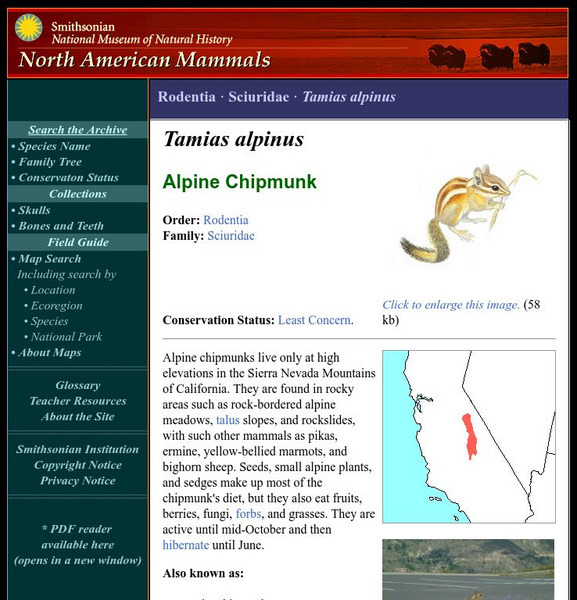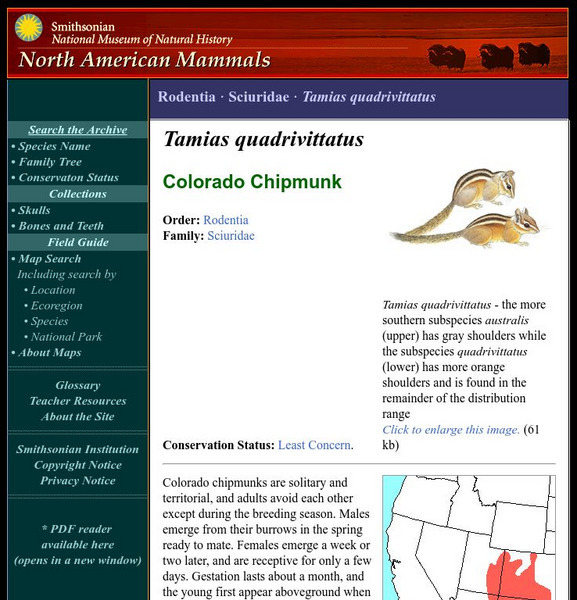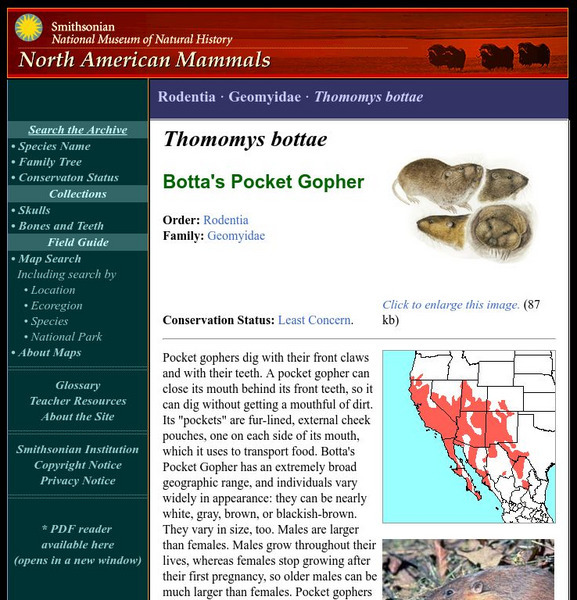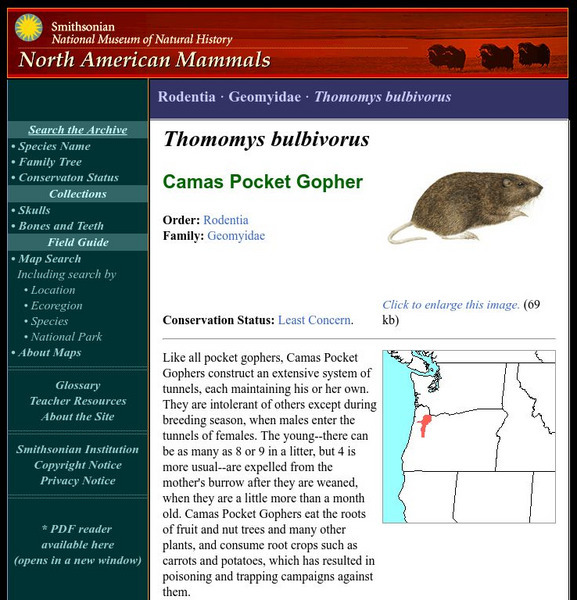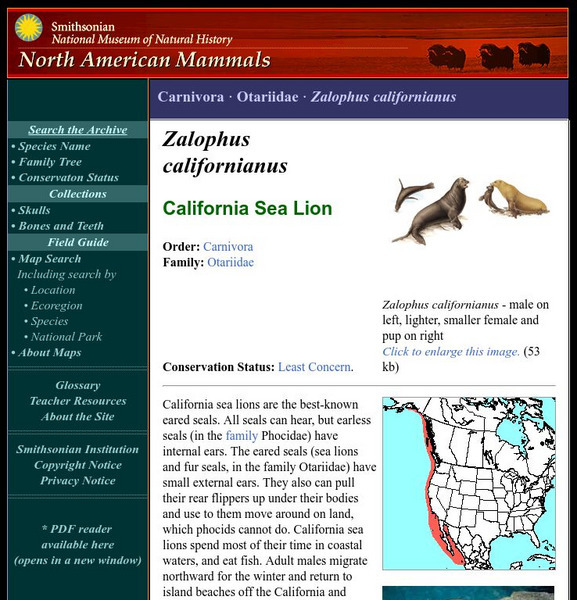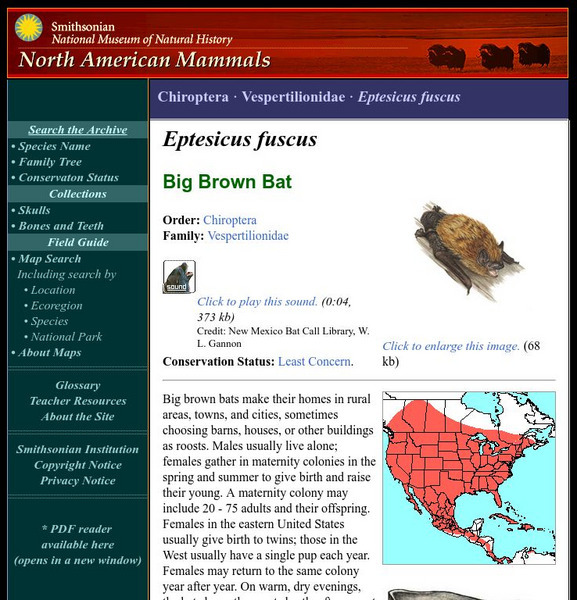Smithsonian Institution
National Museum of Natural History: American Mammals: Cliff Chipmunk
Cliff chipmunk fossils about 2,300 and 8,000 years old have been found in caves in Utah and Nevada. The chipmunks still live in those states, in habitats where sagebrush, fourwing saltbush, chokecherry, wild rose, and cliffrose grow....
Smithsonian Institution
National Museum of Natural History: American Mammals: Alpine Chipmunk
Alpine chipmunks live only at high elevations in the Sierra Nevada Mountains of California. They are found in rocky areas such as rock-bordered alpine meadows, talus slopes, and rockslides, with such other mammals as pikas, ermine,...
Smithsonian Institution
National Museum of Natural History: American Mammals: Colorado Chipmunk
Colorado chipmunks are solitary and territorial, and adults avoid each other except during the breeding season. Males emerge from their burrows in the spring ready to mate. Learn more about the Tamias quadrivittatus, more commonly known...
Smithsonian Institution
National Museum of Natural History: American Mammals: Botta's Pocket Gopher
Pocket gophers dig with their front claws and with their teeth. A pocket gopher can close its mouth behind its front teeth, so it can dig without getting a mouthful of dirt. Learn more about the Thomomys bottae, more commonly known as a...
Smithsonian Institution
National Museum of Natural History: American Mammals: Camas Pocket Gopher
Like all pocket gophers, Camas Pocket Gophers construct an extensive system of tunnels, each maintaining his or her own. They are intolerant of others except during breeding season, when males enter the tunnels of females. Learn more...
Smithsonian Institution
National Museum of Natural History: American Mammals: Bottlenose Dolphin
Bottlenose dolphins have widely spaced eyes, relatively long flippers, a rounded forehead (called a melon), a relatively short, broad snout, and a mouth that seems permanently twisted into a grin. Inside the mouth are as many as 100...
Smithsonian Institution
National Museum of Natural History: American Mammals: Brown Bear, Grizzly Bear
Brown Bears are solitary, powerful predators who can be aggressive to one another. There is a social hierarchy: adult males are dominant, and females with cubs are dominant over juvenile males and females without cubs. Learn more about...
Smithsonian Institution
National Museum of Natural History: American Mammals: California Sea Lion
California sea lions are the best-known eared seals. All seals can hear, but earless seals (in the family Phocidae) have internal ears. Learn more about the Zalophus californianus, more commonly known as a California Sea Lion, in this...
Smithsonian Institution
National Museum of Natural History: American Mammals: Black Tailed Prairie Dog
Black-tailed prairie dogs exhibit the most complex social behavior of all prairie dogs. Social groups called "coteries" live together in very large colonies called "towns. Learn more about the Cynomys ludovicianus, more commonly known as...
Smithsonian Institution
National Museum of Natural History: American Mammals: Big Brown Bat
Big brown bats make their homes in rural areas, towns, and cities, sometimes choosing barns, houses, or other buildings as roosts. Males usually live alone; females gather in maternity colonies in the spring and summer to give birth and...
Smithsonian Institution
National Museum of Natural History: American Mammals: Bearded Seal
Bearded seals have relatively small heads and prominent whiskers. Males and females are similar in size and appearance. Learn more about the Erignathus barbatus, more commonly known as a Bearded Seal, in this easy-to-read species...
Smithsonian Institution
National Museum of Natural History: American Mammals: Baird's Pocket Gopher
Baird's Pocket Gopher is also known as the Louisiana Pocket Gopher, though most of what is known about its ecology has come from studies of the species near College Station, Texas, and it occurs in Oklahoma and Arkansas as well as in...
Smithsonian Institution
National Museum of Natural History: American Mammals: Atlantic White Sided Dolphin
Like other species of the genus Lagenorhynchus, the Atlantic white-sided dolphin is a stocky animal with a short, thick snout. It is common in cold North Atlantic waters. Learn more about the Lagenorhynchus acutus, more commonly known as...
Smithsonian Institution
National Museum of Natural History: American Mammals: Pacific White Sided Dolphin
Before the United Nations established a moratorium on the use of high seas drift nets in 1993, Pacific white-sided dolphins were frequently caught in the nets of Japanese and Korean squid fisheries. Today the species is better protected,...
Smithsonian Institution
National Museum of Natural History: American Mammals: Alaskan Hare
Female Alaskan Hares nurse their young for an extended period, providing them with enough nutrition to grow extraordinarily quickly during the short Alaskan summer. There is an average of six furry little hares in a litter, and females...
Smithsonian Institution
National Museum of Natural History: American Mammals: Northern Right Whale Dolphin
With no dorsal fin, a slender body shape that tapers steadily toward the tail, and small flippers and flukes, the northern right whale dolphin appears to be built for speed. It has been clocked at 34 km per hour and can dive as deep as...


